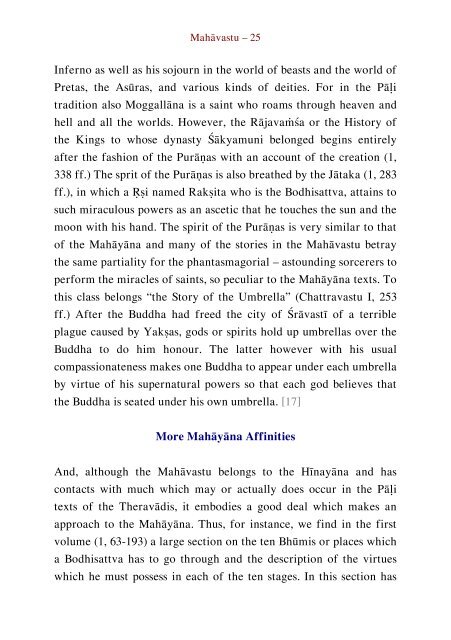Literary History of Sanskrit Buddhism
A study by J. K. Nariman of Sanskrit Buddhism from the Early Buddhist Tradition up to the Mahayana texts proper.
A study by J. K. Nariman of Sanskrit Buddhism from the Early Buddhist Tradition up to the Mahayana texts proper.
You also want an ePaper? Increase the reach of your titles
YUMPU automatically turns print PDFs into web optimized ePapers that Google loves.
Mahāvastu – 25<br />
Inferno as well as his sojourn in the world <strong>of</strong> beasts and the world <strong>of</strong><br />
Pretas, the Asūras, and various kinds <strong>of</strong> deities. For in the Pāḷi<br />
tradition also Moggallāna is a saint who roams through heaven and<br />
hell and all the worlds. However, the Rājavaṁśa or the <strong>History</strong> <strong>of</strong><br />
the Kings to whose dynasty Śākyamuni belonged begins entirely<br />
after the fashion <strong>of</strong> the Purāṇas with an account <strong>of</strong> the creation (1,<br />
338 ff.) The sprit <strong>of</strong> the Purāṇas is also breathed by the Jātaka (1, 283<br />
ff.), in which a Ṛṣi named Rakṣita who is the Bodhisattva, attains to<br />
such miraculous powers as an ascetic that he touches the sun and the<br />
moon with his hand. The spirit <strong>of</strong> the Purāṇas is very similar to that<br />
<strong>of</strong> the Mahāyāna and many <strong>of</strong> the stories in the Mahāvastu betray<br />
the same partiality for the phantasmagorial – astounding sorcerers to<br />
perform the miracles <strong>of</strong> saints, so peculiar to the Mahāyāna texts. To<br />
this class belongs “the Story <strong>of</strong> the Umbrella” (Chattravastu I, 253<br />
ff.) After the Buddha had freed the city <strong>of</strong> Śrāvastī <strong>of</strong> a terrible<br />
plague caused by Yakṣas, gods or spirits hold up umbrellas over the<br />
Buddha to do him honour. The latter however with his usual<br />
compassionateness makes one Buddha to appear under each umbrella<br />
by virtue <strong>of</strong> his supernatural powers so that each god believes that<br />
the Buddha is seated under his own umbrella. [17]<br />
More Mahāyāna Affinities<br />
And, although the Mahāvastu belongs to the Hīnayāna and has<br />
contacts with much which may or actually does occur in the Pāḷi<br />
texts <strong>of</strong> the Theravādis, it embodies a good deal which makes an<br />
approach to the Mahāyāna. Thus, for instance, we find in the first<br />
volume (1, 63-193) a large section on the ten Bhūmis or places which<br />
a Bodhisattva has to go through and the description <strong>of</strong> the virtues<br />
which he must possess in each <strong>of</strong> the ten stages. In this section has


















